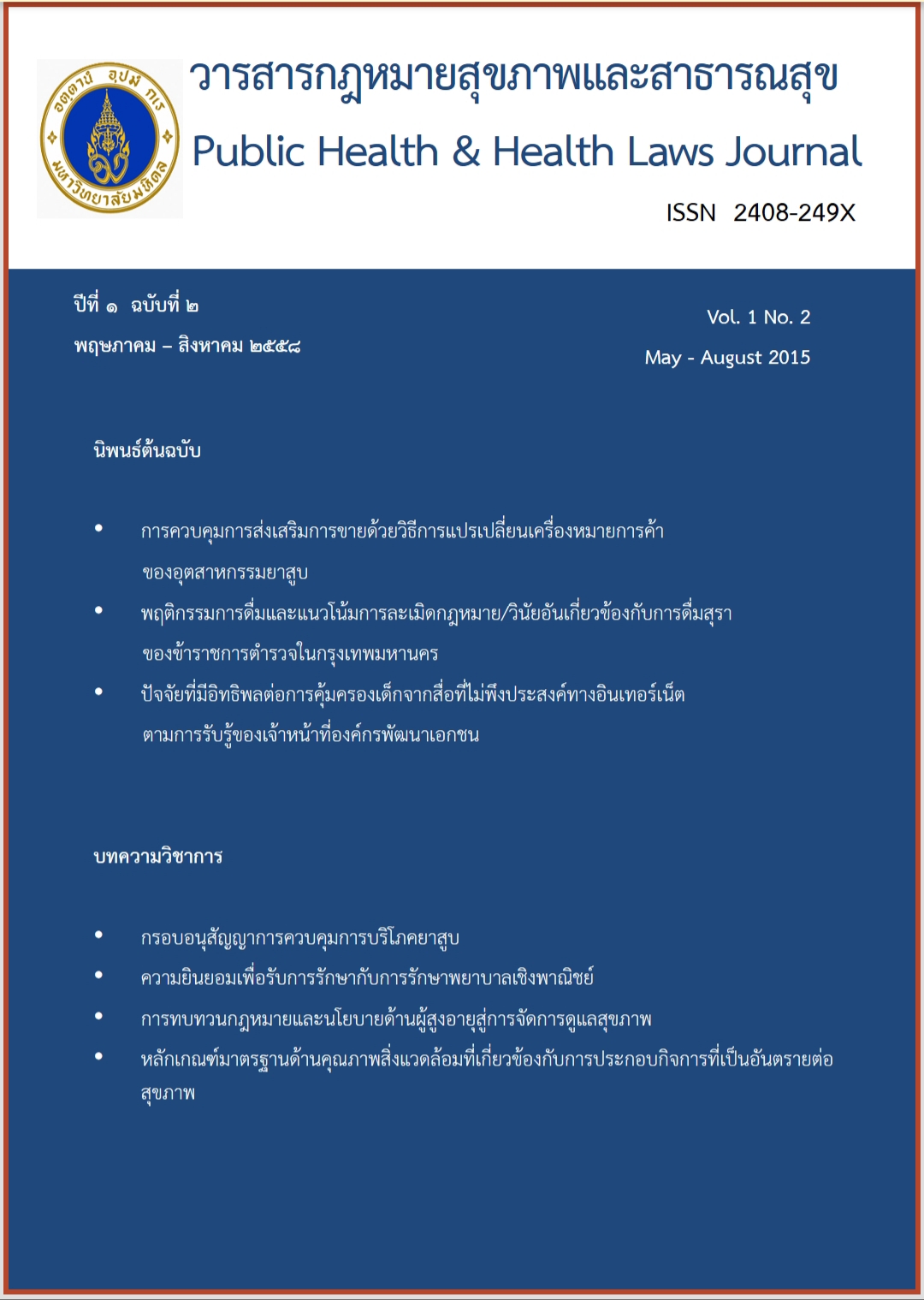Factors That Influence Protection of Children by NGOS From Undesirable Media through Internet
Keywords:
children’s protection, undesirable media on internet, children’s protection collaborationAbstract
The object of this research was to survey factors that influence children’s protection from undesirable media according to personnel of non-governmental organizations (NGOS). Data were collected, then analyzed using descriptive statistics and analytical statistics such as Chi-square, Pearson’s product moment correlation coefficient, and multiple regression to determine the significance of survey results.
This research found that NGOS in collaboration with governmental agencies are most effective in protecting children from exploitation from undesirable media, having an average score of 3.86. NGOS and governmental agencies have the least collaboration on policy of children’s protection with an average score of 3.67. Personnel in the survey are reasonably knowledgeable (57.8%) about laws protecting children from undesirable media through the internet. Most of the surveyed subjects (97.2%) answered correctly to questions related to the children’s protection bill of B.E.2546. The majority indicated that the most important project in children’s protection is the prevention of children’s sexual exploitation from the internet, having an average score of 4.69. The collaboration factor between NGOS and governmental agencies and knowledge of the laws factor had relationship and influence on the effectiveness of protecting children from undesirable media through the internet, which could explain predictive power of 38.1%. These results suggest that there should be a greater collaboration between private foundations and governmental agencies and personnel should be encouraged to know the law protecting children from undesirable media on internet.
References
นันท์นภัส สนธิพร. (2552). มาตรการทางกฎหมายในการควบคุมสื่อลามกและสื่อที่ไม่เหมาะสมเพื่อคุ้มครองเด็กและเยาวชน ศึกษากรณีร่างพระราชบัญญัติปราบปรามวัตถุยั่วยุพฤติกรรมอันตราย พ.ศ. .... วิทยานิพนธ์นิติศาสตรมหาบัณฑิต, สาขาวิชานิติศาสตร์ คณะนิติศาสตร์ จุฬาลงกรณ์มหาวิทยาลัย.
ปัทมา แสงสะอาด.(2547). ทัศนะของชุมชนต่อการคุ้มครองเด็ก:ศึกษาเฉพาะกรณีชุมชนวัดประชาระบือธรรม เขตดุสิต จังหวัดกรุงเทพมหานคร. วิทยานิพนธ์สังคมสงเคราะห์ศาสตรมหาบัญฑิต, มหาวิทยาลัยธรรมศาสตร์.
ปริมา อภิโชติกร. (2551). อิทธิพลของสื่อลามกที่มีต่อพฤติกรรมทางเพศของนักศึกษากลุ่มอาชีวศึกษาจังหวัดเชียงใหม่. วิทยานิพนธ์ศิลปศาสตรมหาบัณฑิต, สาขาวิชานิเทศศาสตร์ สำนักงานบัณฑิตศึกษา มหาวิทยาลัยแม่โจ้.
มูลนิธิปวีณา หงสกุลเพื่อเด็กและสตรี.(2555). วันที่ค้นข้อมูล 4 ธันวาคม 2555, จากมูลนิธิปวีณา หงสกุลเพื่อเด็กและสตรีเว็บไซต์ :http://www.pavenafoundation.or.th/
พรทิพย์ ศิริชูทรัพย์ .(2542). การเปิดรับข่าวสารความรู้ ทัศนคติและการมีส่วนร่วมต่อปัญหาสังคมของกลุ่มผู้ใช้สื่ออินเตอร์เน็ทบนเว็ปไซต์ขององค์กรพัฒนาเอกชน. วิทยานิพนธ์. จุฬาลงกรณ์มหาวิทยาลัย
สภาองค์กรพัฒนาเด็กและเยาวชน .(2555). วันที่ค้นข้อมูล 4 ธันวาคม 2555, จากสภาองค์กรพัฒนาเด็กและเยาวชนเว็บไซต์: http://www.dordek.org.
โสมนัส เจือศรีกุล. (2545). มาตรการควบคุมต่อต้านสื่อลามกเด็ก. วิทยานิพนธ์นิติศาสตรมหาบัณฑิต, จุฬาลงกรณ์มหาวิทยาลัย.
องค์กรพัฒนาการคุ้มครองเด็กและมูลนิธิเพื่อยุติการแสวงประโยชน์ทางเพศจากเด็ก.(2555). วันที่ค้นข้อมูล 4 ธันวาคม 2555, จากองค์กรพัฒนาการคุ้มครองเด็กและมูลนิธิเพื่อยุติการแสวงหาประโยชน์ทางเพศจากเด็กเว็บไซต์: http://www.ecpatthailand.org/th/about.html.
เอ็คแพทอินเตอร์เนชั่นแนล. (2549). การติดตามผลระดับสากลรายงานว่าด้วยความก้าวหน้าของการดำเนินงานต่อต้านการแสวงหาประโยชน์ทางเพศเชิงพาณิชย์จากเด็ก.กรุงเทพฯ:ศาลาแดง.
Downloads
Published
How to Cite
Issue
Section
License
Disclaimer and Copyright Notice
The content and information presented in articles published in the Journal of Law and Public Health Policy represent the opinions and sole responsibility of the respective authors. The editorial board does not necessarily agree with or assume any responsibility for the views expressed.
All articles, data, content, images, and other materials published in the Journal of Law and Public Health Policy are the intellectual property of the journal. Any individual or organization wishing to reproduce, distribute, or otherwise use the entirety or any part of such materials must provide proper citation.





